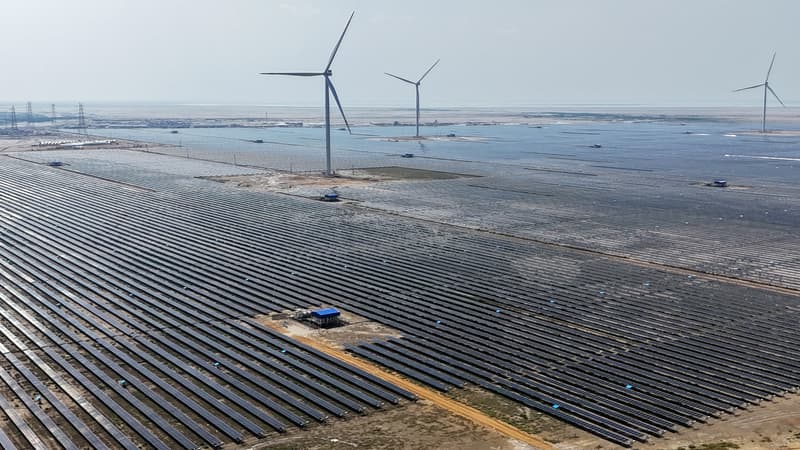India has announced in recent days that 50% of its electricity production capacity was of renewable origin, five years before the calendar set by the Treaty of Paris. This success was well received by the Government, but, according to environmental NGOs, the road to the carbon neutrality of the third polluting on the planet remains long.
According to the Minister of Renewable Energies, Palhad Joshi, 242.8 of the 484.8 Gigawatts (GW) of the electrical production capacity available for the country is provided by non -fossil fuels. These “installed” capabilities called thus arrived at the end of June of Solar Energy (116 GW), ahead of hydroelectric (54 GW), wind (52 GW), bioenergies (12 GW) and nuclear (9 GW), according to the ministry.
Largest solar farm in the world
India, whose production capacity in renewable energies has tripled in the last ten years, has also crossed this ribbon five years before the deadline established in 2015 in Paris. “In terms of solar energy production capacity, India has surpassed Germany and Japan and occupies third place in the world” behind China and the United States, the ministry said.
The subcontinent giant does not intend to stop there. He wants to pass the 500 GW milestone of the production capacity to renewable energies at the expiration of 2030. The largest solar “company” in the world, with a capacity of 30 GW, must enter service in full power by 2029 in the Indian desert of Gujarat.
The government’s announcement is “significant,” acknowledges Avantika Goswami, of the Center for Science and the Environment (CSE) in New Delhi, especially because India “has the growing energy needs.” But, he added immediately, we must not confuse production capacity and production. Official figures confirm this: 73% of electricity consumed in India remains generated by very polluting central coal. Only 13% come from solar panels or wind turbines.
“Without storage, let’s lose”
By definition, solar and wind energies are intermittent, subject to the limitations of nature and not very effective when it comes to responding to consumption peaks. This would be necessary to considerably increase the storage capacities of the electricity produced by the sun and the wind. “Our capacity in renewable energies increases rapidly: 25 to 30 GW every year,” says Palhad Joshi.
India currently has only one storage capacity of 505 megawatts per hour (MWH), clearly insufficient. She has invested invested in developing it. The storage also raises the issue of the dependence of India against China, the main world producer of the essential world for the manufacture of batteries. “This is a strategic concern,” says Harjet Singh, of the Climate Foundation.
Therefore, coal should remain the king of the electricity market for a long time. Only carbon or nuclear energy dams can meet the growing electricity needs in the country in the world (1.4 billion inhabitants). The Indian Park of Coal Electric Centers is young, 60% are under fifteen, and replace the thermal electric power plants would be ruined.
7% of world CO2 emissions
However, India ensures that it is able to have its ambitious objectives to reduce greenhouse gases. “We are online to get there,” they say to the government. The bar is high: 45% drop in carbon emissions by 2030 and neutrality in 2070. India is responsible for 7% of world CO2 emissions, far behind China and the United States.
To improve its performance, while the demand for electricity should still be doubled within two years, the CSE insists on a better efficiency of coal power plants.
Source: BFM TV


